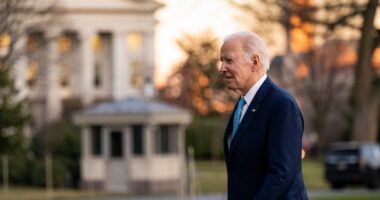
CAPE CANAVERAL — The world’s biggest, most powerful space telescope arrived at its observation post 1 million miles from Earth on Monday, a month after it lifted off on a quest to behold the dawn of the universe.
On command, the James Webb Space Telescope fired its rocket thrusters for nearly five minutes to go into orbit around the sun at its designated location, and NASA confirmed the operation went as planned.
The mirrors on the $10 billion observatory still must be meticulously aligned and the infrared detectors sufficiently chilled before science observations can begin in June. But flight controllers in Baltimore were euphoric after chalking up another success.
“We’re one step closer to uncovering the mysteries of the universe. And I can’t wait to see Webb’s first new views of the universe this summer!” NASA Administrator Bill Nelson said in a statement.
The telescope will enable astronomers to peer back further in time than ever before, all the way back to when the first stars and galaxies were forming 13.7 billion years ago. That’s a mere 100 million years from the Big Bang, when the universe was created.
Besides making stellar observations, Webb will scan the atmospheres of alien worlds for possible signs of life.
The high-flying drama began within days of liftoff.
A sunshield as big as a tennis court stretched open on the telescope in early January, 1 1/2 weeks after the Christmas Day launch from French Guiana. The observatory’s gold-coated mirror — 21 feet (6.5 meters) across — unfolded a few days later.
Monday’s thruster firing put the telescope into orbit around the sun at the so-called second Lagrange point, where the gravitational forces of the sun and Earth balance. The 7-ton spacecraft always faces Earth’s night side to keep its infrared detectors as frigid as possible.
At 1 million miles (1.6 million kilometers) away, Webb is more than four times as distant as the moon.
“Wow, what a ride this last month it’s been,” said Amber Straughn, a deputy project scientist for NASA.
Considered the successor to the Hubble Space Telescope, which orbits 330 miles (530 kilometers) up, Webb is too far away for emergency repairs. That makes the milestones over the past month — and the ones ahead — all the more critical.
Spacewalking astronauts performed surgery five times on Hubble. The first operation, in 1993, corrected the telescope’s blurry vision, a flaw introduced during the mirror’s construction on the ground.
Whether chasing optical and ultralight light like Hubble or infrared light like Webb, telescopes can see farther and more clearly when operating above Earth’s distorting atmosphere. That’s why NASA teamed up with the European and Canadian space agencies to get Webb and its massive mirror — the largest ever launched — out into the cosmos.
Source: | This article originally belongs to Nbcnews.com










